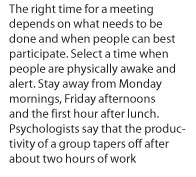.jpg) Staff meetings have become a vital and inevitable part of day-to-day business. If conducted with proper etiquette, all participants – including the leader can leave the meeting with that warm feeling that they have accomplished a lot, rather than suffering through another one of those dreary events that took up valuable time and achieved relatively nothing.
Staff meetings have become a vital and inevitable part of day-to-day business. If conducted with proper etiquette, all participants – including the leader can leave the meeting with that warm feeling that they have accomplished a lot, rather than suffering through another one of those dreary events that took up valuable time and achieved relatively nothing.
Yes, staff meetings can really be fun and interesting. We just have to build them that way.
Rules for meeting participant
If you are only a participant, these are the applicable rules.
Arriving prepared, contributing ideas and following up with decisions are the keys to making a staff meeting meaningful, productive and exciting.
Before the meeting, inquire about what’s going to be discussed and what the goals are. Think about how you can contribute. What important message do you want to get across? This message becomes your mission and your contribution to the meeting. It might not be a related topic, but an important message about a corporate concern or project.
Think of your message as a short commercial. Come prepared with well-thought through suggestions and supporting information. Rehearse your presentation several times. Try writing a grabber sentence for your opener and another for a strong ending. Then condense the rest of your thoughts to an outline using short phrases to trigger your thoughts.
Stay alert. If you want people to listen to what you have to say, you must be attentive and interested in the meeting’s agenda. Take notes. Ask questions if you need more information or question the wisdom of a decision. Deliver your message. Unless you have planned a certain time in advance with the meeting leader, you’ll have to find a suitable moment to contribute your message.
Two possible ways to do that include: (1) Answer a question and then make a smooth transition to your topic. You can say, “... and that question reminds me of another important issue.” Then, state your message: (2) Respond to a statement someone else has said with, “That’s a very important point and I would like to make another point about...”
What happens after a meeting can be just as important as what takes place during it. Ideas presented must be implemented and decisions carried out. Even as a participant, you can help to ensure that the decisions made become realities. Meeting follow-ups can give you great opportunities for building a reputation for leadership. You might, for example, offer to present the group’s concern for more flexible scheduling to your department head, then follow through in getting a response.
If you follow these steps, the meeting leader will know you’re not just another participant, but an employee who’s genuinely interested in your company.

Rules for meeting leader
If you are the leader of the meeting, then the rules are slightly different.
-
Decide why you are calling the meeting
Any staff meeting should have a purpose. Just because “we always have a staff meeting at 3 p.m. on Mondays” is no reason to have it. Staff meetings should give employees an opportunity to ask questions and give reactions. Meetings also enable managers to make sure everyone gets the same information the same way and that all staff understand where they fit in a project. Staff meetings have one or more purposes: To share information, generate ideas, define or solve a problem, recognize achievement, build morale.
The right people are those who need to be there, those who can contribute because of their unique knowledge and experience. Right people are those who have the power to make a decision, the power to implement a decision. The number of people should also be right. How many depends on what they are expected to do; like, if to make a decision or solve a problem, five or fewer, to identify a problem, 10 or fewer, to receive hands-on training, 15 or fewer, to share info or to view a presentation, not more than 30. The thumb rule to be followed is larger the group, the shorter the meeting.
An agenda organises a meeting. In writing down what will be covered, the leader recognizes the order in which the topic must be discussed as well as the time needed to cover each topic. During the meeting, this agenda helps him to focus attention on the tasks at hand. A good agenda states the meeting’s objective which explains why the meeting is necessary and provides the leader with a good way to open the meeting. The agenda should also state the date, start time and finish time, topics to be covered, who will present each topic, etc.
-
Choose effective presentation aids
When a meeting presents new information such as talking about a new product, staff members will remember it better when they see it in graphic images. Likewise, when they must assimilate masses of data-sales, expenses, technical material, etc., they will be able to do it more quickly when it is presented visually.
In selecting a visual, three factors should be taken into consideration: Preparation time, cost and overall effectiveness. Chalkboards are the least expensive type. They can be used for small groups. Overhead transparencies can be used to display charts, drawings as well as words. They can be projected in a fully lighted room and are effective in small to medium-sized groups. Another type of presentation is slide presentations consisting of 35mm slides which present colour images of people and places and if used in synchronized projectors with sound, can bring about the effect of a motion picture. For best results, they must be viewed in a dimly lit room. These types of presentations are effective with large audiences.
-
Select the right room and right time

The room helps to set the meeting’s tone. The thumb of the rule is that meetings that require group interaction need 25 sq. feet/person. If the meeting consists primarily of presentations, 8 sq. feet/person are sufficient. Also, seating arrangement influences the flow of information and ideas. A theatre set-up is best for giving presentations to large groups, when conversation will be one-way. Similarly, a classroom arrangement with tables and chairs facing the front, works well for training a small group. Seating arranged in a semicircle will increase eye contact and other non-verbal communication, thereby enhancing bonding among participants.
The right time for a meeting depends on what needs to be done and when people can best participate. Select a time when people are physically awake and alert. Stay away from Monday mornings, Friday afternoons and the first hour after lunch. Psychologists say that the productivity of a group tapers off after about two hours of work. In case a meeting lasts longer than that, schedule a short break between sessions. Be precise about start and finish times.
-
Maintain control during the meeting
A good meeting leader doesn’t need the charisma but should have the ability to control. In staff meetings control not only means coordination- i.e. introducing the presenters and managing the meeting time but generating discussion and guiding it towards a solution. In either case, he exercises control by preparing adequately, starting on time and sticking to the agenda. When discussion strays off the topic, the leader can either ignore the remarks or he can ask “Is this subject relevant?” If a person talks too much, the leader should step in tactfully but firmly and enlist his cooperation in allowing others to talk. If that doesn’t work, the leader can give him a time limit of say, for example, “I understand your point. Now let’s hear from someone else.”
-
Follow-up after the meeting
When the meeting is over, it’s not really over. Even though the meeting may have ended with a good oral summary, the leader should prepare a brief written summary and distribute it to participants within the next two days. These action minutes serve as an official record of the meeting. By recapping who is expected to do what, by when, the minutes become a tool for follow-up and feedback. Most important, they provide evidence of work accomplished and let people know that their time was well spent.
Staff meetings when run well are powerful communication tools for executives and managers alike in achieving an organisation’s goals. They are also marvelous opportunities to practice one’s leadership skills and to earn recognition from colleagues and superiors.
(The writer is a senior corporate director with extensive managerial experience. He can be contacted on [email protected])
.jpg) Staff meetings have become a vital and inevitable part of day-to-day business. If conducted with proper etiquette, all participants – including the leader can leave the meeting with that warm feeling that they have accomplished a lot, rather than suffering through another one of those dreary events that took up valuable time and achieved relatively nothing.
Staff meetings have become a vital and inevitable part of day-to-day business. If conducted with proper etiquette, all participants – including the leader can leave the meeting with that warm feeling that they have accomplished a lot, rather than suffering through another one of those dreary events that took up valuable time and achieved relatively nothing.
 The room helps to set the meeting’s tone. The thumb of the rule is that meetings that require group interaction need 25 sq. feet/person. If the meeting consists primarily of presentations, 8 sq. feet/person are sufficient. Also, seating arrangement influences the flow of information and ideas. A theatre set-up is best for giving presentations to large groups, when conversation will be one-way. Similarly, a classroom arrangement with tables and chairs facing the front, works well for training a small group. Seating arranged in a semicircle will increase eye contact and other non-verbal communication, thereby enhancing bonding among participants.
The room helps to set the meeting’s tone. The thumb of the rule is that meetings that require group interaction need 25 sq. feet/person. If the meeting consists primarily of presentations, 8 sq. feet/person are sufficient. Also, seating arrangement influences the flow of information and ideas. A theatre set-up is best for giving presentations to large groups, when conversation will be one-way. Similarly, a classroom arrangement with tables and chairs facing the front, works well for training a small group. Seating arranged in a semicircle will increase eye contact and other non-verbal communication, thereby enhancing bonding among participants.